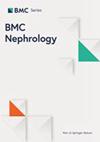eskd 风险估计和及时的肾脏替代疗法教育
IF 2.2
4区 医学
Q2 UROLOGY & NEPHROLOGY
引用次数: 0
摘要
肾脏替代疗法(KRT)需要做好准备,其时机也很难预测。肾科医生对肾衰竭风险的预测往往比肾衰竭风险方程(KFRE)的预测更悲观。我们旨在探讨医生的风险估计与转诊至 KRT 教育的关系,以及客观计算的 KFRE 的关系。这项前瞻性观察研究收集了退伍军人事务医疗中心圣迭戈分中心和加州大学圣迭戈分校慢性肾脏病 (CKD) 诊所的数据。该研究包括 257 名年龄在 18 岁或以上、讲英语、慢性肾脏病诊所流行病患者,估计肾小球滤过率 (eGFR) < 60 mL/min per 1.73 m2(MDRD 方程)。暴露包括终末期肾病(ESKD)风险预测。对肾病专家的肾衰竭风险估计进行了评估:"在 0-100% 的范围内,在不使用任何估计方程的情况下,给出您对该患者 2 年后需要透析或肾移植的风险的最佳估计"。计算 KFRE 时使用了年龄、性别、eGFR、血清碳酸氢盐、白蛋白、钙、磷、尿白蛋白/肌酐比值。研究结果是转诊接受 KRT 教育的模式(初诊后 90 天内)和通过病历审查评估的肾衰竭情况。根据肾病专家的预测或 KFRE 将人群分为不同组别。按照组别对转诊接受 KRT 教育的情况进行检查,并根据参与者是否在 2 年后出现肾衰竭计算敏感性和特异性。五分之一的患者在入组 90 天内转诊接受教育。根据这两项估计,低风险患者的转诊率较低。在肾病专家预测值≥15%(n = 137)的患者中,敏感性为 71%,特异性为 76%。在 KFRE≥15% 的患者中(n = 55),敏感性为 85%,特异性为 41%。虽然肾科医生倾向于高估患者的肾衰竭风险,但他们似乎并没有根据高估的风险采取行动,因为当肾科医生将患者确定为高风险时,KRT 教育转诊率低于预期。不适用本文章由计算机程序翻译,如有差异,请以英文原文为准。
Estimates of eskd risk and timely kidney replacement therapy education
Kidney replacement therapy (KRT) needs preparation and its timing is difficult to predict. Nephrologists’ predictions of kidney failure risk tend to be more pessimistic than the Kidney Failure Risk Equation (KFRE) predictions. We aimed to explore how physicians’ risk estimate related to referral to KRT education, vs. the objective calculated KFRE. Prospective observational study of data collected in chronic kidney disease (CKD) clinics of the Veterans Affairs Medical Center San Diego and the University of California, San Diego. The study included 257 participants who were aged 18 years or older, English speaking, prevalent CKD clinic patients, with estimated glomerular filtration rate (eGFR) < 60 mL/min per 1.73 m2 (MDRD equation). The exposure consisted of end stage kidney disease (ESKD) risk predictions. Nephrologists’ kidney failure risk estimations were assessed: “On a scale of 0–100%, without using any estimating equations, give your best estimate of the risk that this patient will need dialysis or a kidney transplant in 2 years.” KFRE was calculated using age, sex, eGFR, serum bicarbonate, albumin, calcium, phosphorus, urine albumin/creatinine ratio. The outcomes were the pattern of referral to KRT education (within 90 days of initial visit) and kidney failure evaluated by chart review. The population was divided into groups either by nephrologists’ predictions or by KFRE. Referral to KRT education was examined by group and sensitivity and specificity were calculated based on whether participants reached kidney failure at 2 years. A fifth were referred for education by 90 days of enrollment. Low risk patients by both estimates had low referral rates. In those with nephrologists’ predictions ≥ 15% (n = 137), sensitivity was 71% and specificity 76%. In those with KFRE ≥ 15% (n = 55), sensitivity was 85% and specificity 41%. Although nephrologists tend to overestimate patients’ kidney failure risk, they do not appear to act on this overestimation, as the rates of KRT education referrals are lower than expected when a nephrologist identifies a patient as high risk. Not applicable
求助全文
通过发布文献求助,成功后即可免费获取论文全文。
去求助
来源期刊

BMC Nephrology
UROLOGY & NEPHROLOGY-
CiteScore
4.30
自引率
0.00%
发文量
375
审稿时长
3-8 weeks
期刊介绍:
BMC Nephrology is an open access journal publishing original peer-reviewed research articles in all aspects of the prevention, diagnosis and management of kidney and associated disorders, as well as related molecular genetics, pathophysiology, and epidemiology.
 求助内容:
求助内容: 应助结果提醒方式:
应助结果提醒方式:


